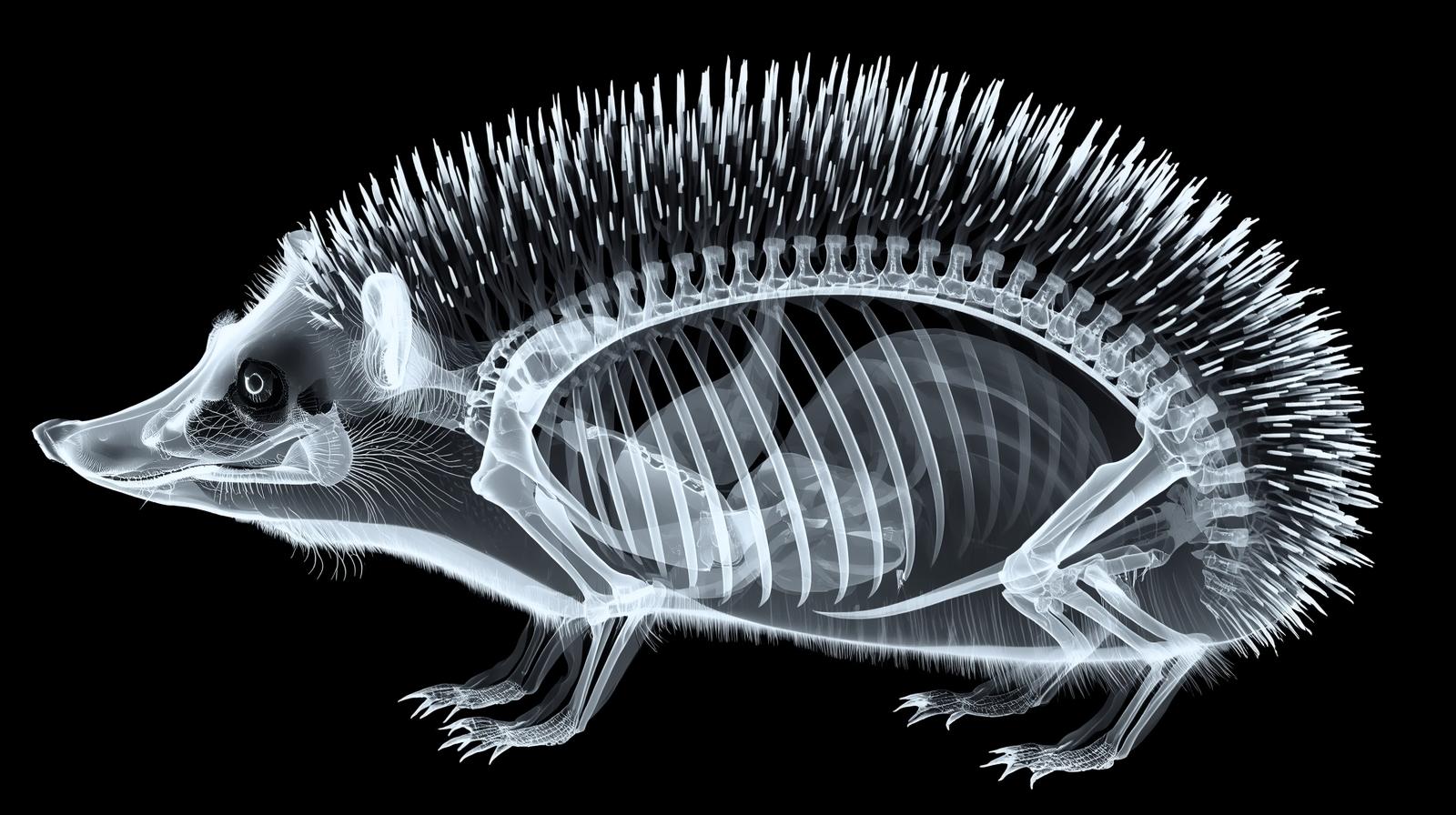Health
Understanding Hedgehog X-rays: What Every Owner and Vet Should Know
Published
2 weeks agoon

Hedgehogs are adorable, spiky little mammals that have become popular pets around the world. They’re small, quiet, and fascinating to observe, but like all animals, hedgehogs can suffer from health issues that need professional attention. One of the most powerful tools veterinarians use to diagnose hedgehog health problems is the X-ray.
A hedgehog X-ray gives a detailed look inside the animal’s body, showing bones, internal organs, and sometimes even blockages or tumors. Because hedgehogs can’t communicate how they feel, these images help vets understand what’s happening inside. Whether it’s an injury, respiratory issue, or dental concern, X-rays play a vital role in diagnosing and treating hedgehogs effectively.
What Is an X-ray and Why Is It Important for Hedgehogs?
An X-ray (radiograph) is a diagnostic imaging technique that uses electromagnetic radiation to create pictures of the inside of the body. When X-rays pass through a hedgehog’s body, dense materials like bones absorb more rays and appear white on the image, while softer tissues appear gray.
In hedgehogs, this simple yet powerful tool helps reveal hidden issues. For example:
- Broken bones after a fall or accident
- Dental diseases, like overgrown teeth or abscesses
- Lung infections or pneumonia
- Tumors or abnormal masses
- Digestive blockages or gas buildup
Since hedgehogs are small, most veterinarians use high-resolution X-ray machines with precise settings to ensure clear, detailed images without exposing the animal to unnecessary radiation.
When Does a Hedgehog Need an X-ray?
Not every health issue requires an X-ray, but vets recommend it in several specific situations.
1. Injury or Trauma
If a hedgehog falls from a height, gets stepped on accidentally, or experiences any kind of trauma, an X-ray can reveal fractures, dislocated joints, or internal bleeding. Because hedgehogs tend to curl up tightly when scared or in pain, visual examination alone is often not enough to spot these injuries.
2. Respiratory Problems
Sneezing, wheezing, or labored breathing may signal lung infection or pneumonia. An X-ray of the chest helps vets evaluate the lungs and detect fluid buildup, inflammation, or any abnormal structures.
3. Digestive Issues
Hedgehogs can suffer from constipation, intestinal blockages, or swallowed foreign objects. Abdominal X-rays show gas patterns, enlarged organs, or items trapped inside the digestive tract.
4. Tumors and Cancers
Unfortunately, hedgehogs are prone to cancer as they age. X-rays are used to identify tumors in the chest, abdomen, or limbs, helping guide further tests or surgical plans.
5. Dental Problems
Overgrown teeth, abscesses, or jaw misalignment are common in older hedgehogs. Dental X-rays help vets visualize root infections or bone loss that may not be visible during an oral exam.
How Vets Perform an X-ray on a Hedgehog
Because hedgehogs curl up defensively when nervous, taking an X-ray can be tricky. To get accurate results, vets usually need the hedgehog to be relaxed and positioned properly.
Step 1: Sedation or Light Anesthesia
In most cases, the vet will sedate or lightly anesthetize the hedgehog. This is safe when done by an experienced exotic animal vet. It helps the hedgehog stay still during imaging and prevents stress.
Step 2: Positioning
Once calm, the hedgehog is gently placed on the X-ray table in specific positions depending on which body area needs examination. For example:
- Dorsoventral view (top-down) for chest or abdomen
- Lateral view (side) for bones and spine
- Dental positioning for head and mouth
Step 3: Taking the Image
The vet adjusts the X-ray settings for the hedgehog’s size and density. The exposure time is very short just a fraction of a second to capture a clear image.
Step 4: Reviewing the Radiograph
After the image appears on screen, the vet studies it carefully, checking for fractures, shadows, or unusual shapes that could indicate a problem.
Step 5: Diagnosis and Treatment Plan
The X-ray results are combined with other findings, such as blood work or physical exams, to reach an accurate diagnosis and start the right treatment.
Safety of X-rays for Hedgehogs
Many owners worry about radiation exposure, but modern veterinary X-ray machines are designed to minimize risk. The radiation levels used for small animals like hedgehogs are extremely low and considered safe.
If your hedgehog needs multiple X-rays over time (for example, to monitor recovery from a fracture), the vet will keep exposure to the absolute minimum necessary. Lead shielding and proper handling further reduce any risk.
It’s also worth noting that X-rays are far safer and less invasive than exploratory surgery. In most cases, the information they provide can prevent unnecessary procedures.
Common Findings in Hedgehog X-rays
Every X-ray tells a story about the hedgehog’s health. Some common findings include:
- Fractures: Cracks or breaks in bones, often due to falls.
- Arthritis: Joint stiffness or bone spurs in older hedgehogs.
- Dental abscesses: Pockets of infection near tooth roots.
- Pneumonia: Cloudy or white patches in the lungs.
- Abdominal tumors: Rounded masses pressing against organs.
- Foreign bodies: Items like bedding, small toys, or fibers trapped in the gut.
Detecting these problems early often leads to quicker, more effective treatment and a better chance of recovery.
Cost of Hedgehog X-rays
The cost of a hedgehog X-ray varies depending on the clinic, region, and number of images required. On average, expect to pay anywhere from $80 to $250 per session.
Additional costs may apply if the vet needs to use anesthesia, run blood tests, or perform follow-up X-rays. While it may seem expensive, this diagnostic tool often saves time and prevents unnecessary suffering by pinpointing the exact cause of illness early on.
If you own a hedgehog, consider setting aside an emergency vet fund or investing in exotic pet insurance. It can cover X-rays and other essential medical procedures.
Aftercare and Recovery
If your hedgehog needed sedation for the X-ray, it might take an hour or two to fully recover. Keep the animal warm and quiet in its cage, away from bright light or noise. Offer water and its favorite food once it’s alert.
If the X-ray reveals an issue like a fracture, tumor, or infection your vet will outline the next steps. This could include medications, surgery, or follow-up appointments.
Follow all aftercare instructions carefully and monitor your hedgehog’s behavior. Any changes in appetite, movement, or breathing should be reported immediately to the vet.
Preventive Care: Reducing the Need for X-rays
While X-rays are useful, prevention is always better. Regular health checks and safe living conditions can reduce the risk of injuries or illness. Here’s how to keep your hedgehog healthy:
- Provide a soft, secure habitat: Avoid wire floors and sharp edges.
- Maintain a stable temperature: Hedgehogs are sensitive to cold and heat.
- Offer balanced nutrition: Quality commercial hedgehog food, mealworms, and fruits in moderation.
- Regular vet visits: Annual check-ups help detect issues early.
- Safe playtime: Supervise out-of-cage activity to prevent falls.
By following these tips, you can help your hedgehog live a longer, healthier, and happier life and reduce the chances of needing an X-ray.
What to Expect from Your Vet
A good exotic pet veterinarian will explain the procedure clearly and show you the X-ray images afterward. Don’t hesitate to ask questions understanding what’s going on inside your pet helps you care for it better.
If the vet finds something unusual, they may recommend additional imaging such as ultrasound or CT scan for more detail. Working closely with your vet ensures the best outcome for your hedgehog’s health.
Real-Life Case Study: Hedgehog with a Hidden Tumor
To understand the value of X-rays better, let’s look at a real-life example.
A four-year-old African pygmy hedgehog named Poppy was brought to the vet because she had stopped eating and seemed lethargic. A physical exam didn’t reveal much Poppy just curled into a ball whenever handled. The vet decided to take an X-ray.
The results showed a large mass in her abdomen pressing on her intestines. Thanks to the X-ray, the vet diagnosed a tumor early, allowing for timely surgery. Poppy made a full recovery and lived another two happy years.
This case highlights how X-rays can uncover life-threatening conditions that might otherwise go unnoticed.
The Role of Technology in Modern Hedgehog Medicine
Veterinary medicine has advanced rapidly. Digital X-rays now allow instant, high-definition images that can be enlarged or adjusted for better visibility. Some clinics even share the images electronically with specialists for second opinions.
This technology not only speeds up diagnosis but also reduces the need for repeat exposures. Combined with other tools like ultrasound and endoscopy, vets can provide comprehensive care for exotic pets like hedgehogs.
The Emotional Side: Caring for a Sick Hedgehog
Seeing your hedgehog unwell can be heartbreaking. These little animals bond closely with their owners, and any illness feels personal. Remember, getting an X-ray isn’t just about finding problems it’s about giving your pet the best chance to recover.
Comfort your hedgehog before and after the vet visit. Keep handling gentle, and speak softly. The familiarity of your voice and scent can help reduce stress during medical procedures.
Key Takeaways
- X-rays are essential for diagnosing hedgehog health issues such as fractures, infections, or tumors.
- Sedation helps keep the animal calm and still during the procedure.
- Radiation exposure is minimal and safe under veterinary supervision.
- Early diagnosis through X-rays can save your hedgehog’s life.
- Preventive care, safe housing, and good nutrition reduce the likelihood of needing emergency imaging.
Final Thoughts
A hedgehog X-ray might sound like a complex or stressful process, but in reality, it’s one of the safest and most valuable diagnostic tools available. It helps veterinarians see what the naked eye can’t, ensuring quick, accurate treatment for these tiny creatures.
For any hedgehog owner, understanding the importance of X-rays and trusting your vet’s expertise can make all the difference in your pet’s health journey. Early detection, gentle care, and proper follow-up turn a potentially scary experience into a step toward healing and happiness.
So next time your little spiky friend isn’t acting quite right, don’t hesitate to ask your vet if an X-ray might help. It could be the key to uncovering the problem and keeping your hedgehog healthy for years to come.

A Start-Up with Patient Medical Stories

2 Story 2 Car Garage

100 Orange Juice Skip Opening Story

The Transformative Power of Technology in the Modern World

2 Year Mother’s Day Clothes: Adorable Styles to Celebrate the Day in Comfort and Joy

14th Century Clothing: A Detailed Look at Medieval Fashion and Style

Money Storm Slot Game: Where Every Spin Brings the Thrill of Fortune

Triple Double Diamond Free Games Slots: Classic Casino Fun with Big Wins

Best Running Trainers for Shin Splints: Find Comfort, Support, and Relief

Best Hair Products for Shine: Get That Healthy, Glossy Look Naturally

101 Warren Street New York City: Luxury Living in Tribeca

4 Seasons Nail Salon: A Place for Beauty, Relaxation, and Self-Care

10 Provost St Jersey City: A Complete Guide to Modern Living

2222 Jackson Ave Long Island City: A Modern Living Destination

6 Train Express Stops: A Complete Guide for New York City Commuters

Can You Get a Doctor’s Note Without Being Seen? A Complete Guide

Bella Donna Hair Salon: A Blend of Style, Elegance, and Care

Align Doctor Login Everything You Need to Know in Simple Words

Cutting Hair Style A Complete Guide to Modern Trends, Techniques, and Ideas

1920s Paris Business Women: The Bold Voices That Redefined Feminine Power

A Start-Up with Patient Medical Stories

2 Story 2 Car Garage

100 Orange Juice Skip Opening Story

The Transformative Power of Technology in the Modern World

2 Year Mother’s Day Clothes: Adorable Styles to Celebrate the Day in Comfort and Joy

14th Century Clothing: A Detailed Look at Medieval Fashion and Style

Money Storm Slot Game: Where Every Spin Brings the Thrill of Fortune

Triple Double Diamond Free Games Slots: Classic Casino Fun with Big Wins

Best Running Trainers for Shin Splints: Find Comfort, Support, and Relief









